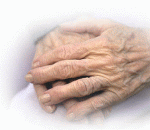Geriatrics
|
18 december 2014 16:51:05 |
| Most functional outcomes are similar for men and women after hip fracture: a secondary analysis of the enhancing mobility after hip fracture trial (BMC Geriatrics) |
|
Tweet Background:
The impact of gender on functional outcomes after hip fracture is not known. We aimed to determine the extent to which gender influenced functional outcome and response to an exercise program in older people after hip fracture, and to determine if any differences persisted after adjusting for cognitive deficits and age.MethodSecondary analysis of data from the Enhancing Mobility After Hip Fracture trial in which older people after surgical fixation for hip fracture received a lower intensity non-weight bearing exercise program (LOW) or a higher intensity weight-bearing exercise program (HIGH). Measures were taken at baseline, week 4 and week 16. Functional outcomes included physical performance (strength, balance and mobility) and self-reported measures (fear of falling, strength, balance, mobility, pain, and overall health). Regression models were used to compare genders at each time point, with adjustment for baseline values, cognition and age. Interaction terms were used to assess whether there was a differential impact of the intervention among men and women.
Results:
Outcome data were available for 160 participants, 30 men (19%) and 130 women (81%) at baseline, and 150 participants (94%) at 16 weeks, withdrawal of 4 men (13%) and 6 women (5%). There were no gender differences for any baseline measures or for most of the 19 functional outcome measures at weeks 4 and 16. At week 4 men performed significantly better (2.1 kg, 95% CI 0.6 to 3.7, p < 0.01) than women in knee extensor strength and this difference persisted after adjusting for baseline values, cognition, and age (p = 0.038) but was not present when knee extension strength was adjusted for body weight. At week 4, men performed better than women in measures of coordinated stability (-10.0 error score, 95% CI -17.6 to -2.4, p = 0.010) and this difference remained significant after adjusting for baseline values but was no longer significant after adjusting for cognition and age (p = 0.073). At week 16, men again performed significantly better in coordinated stability tests (-10.2 error score, 95% CI -18.4 to -1.9, p = 0.016). This gender difference persisted after adjusting for cognitive impairment (p = 0.029) but was no longer significant after adjusting for age and baseline values (p = 0.135). There was no indication of a differential impact of intervention type on the basis of gender.
Conclusions:
Men showed better recovery from a hip fracture than women in one of the six balance measures but no consistent differences were apparent in the other functional outcome measures in response to the intervention. Some observed between gender differences appeared to be confounded by body weight, age and/or cognition. |
| 120 viewsCategory: Geriatrics |
 Reablement in community-dwelling adults: study protocol for a randomised controlled trial (BMC Geriatrics) Reablement in community-dwelling adults: study protocol for a randomised controlled trial (BMC Geriatrics)Long-term prediction of changes in health status, frailty, nursing care and mortality in community-dwelling senior citizens - results from the longitudinal urban cohort ageing study (LUCAS) (BMC Geriatrics) 
|
| blog comments powered by Disqus |
MyJournals.org
The latest issues of all your favorite science journals on one page
The latest issues of all your favorite science journals on one page



